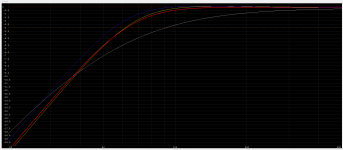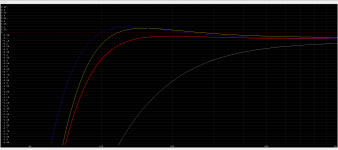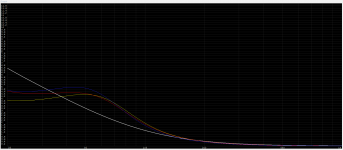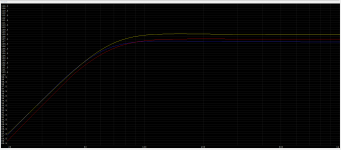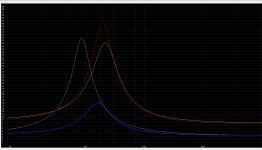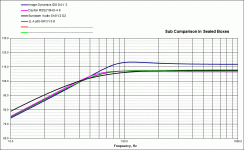Hi everyone,
I wanted to ask the experienced users here what they think about the WinISD graphs and how they correlate to SQ. I am trying to buy a good sub to put in my car and now that I've learned how to use WinISD and Unibox, I just want to understand how the graphs correlate with SQ. I tried to have a technical discussion in a few other forums, but so far it has been impossible. After reading a lot of helpful threads through google search, I realized that this forum is one of the more advanced ones.
I already have a sealed box at 7.86L (0.278 cf) inner volume and my goal is to use it for a new 8" sub/
Here are the four subs (all 8") along with their specs that I am trying to decide on:
I have also attached the WinISD results and the projects (.wpr crated in WinISD Pro 0.7), if you wanted to verify anything. Quick note: I have normal amount of polyfill in my box, so I set Qa=15 and also set the Ql=7 since I read that most systems have that much leakage. They are the same for all subs.
Here is the legend for the graph colors:
White - SA
Yellow - ID
Red - JL
Blue - Dayton
Here are the image titles:
1. Transfer Function Magnitude
2. Same as above, but zoomed in
3. Group Delay
4. Max SPL
5. Impedance
I am trying to figure out which one would be best for my car. It seems that the sub with the best Qtc is the JL Audio at 0.749, but I am not sure if that alone is a good predictor of SQ. I am mostly trying to understand how does the transfer function magnitude translate into SQ and whether such small differences between subwoofers even matter given the non-ideal situation of a speaker being placed in a trunk.
I wanted to ask the experienced users here what they think about the WinISD graphs and how they correlate to SQ. I am trying to buy a good sub to put in my car and now that I've learned how to use WinISD and Unibox, I just want to understand how the graphs correlate with SQ. I tried to have a technical discussion in a few other forums, but so far it has been impossible. After reading a lot of helpful threads through google search, I realized that this forum is one of the more advanced ones.
I already have a sealed box at 7.86L (0.278 cf) inner volume and my goal is to use it for a new 8" sub/
Here are the four subs (all 8") along with their specs that I am trying to decide on:
- JL Audio 8W3v3-4
- Sundown Audio SA-8 v2 D2
- Dayton RSS210HO-4
- Image Dynamics ID8D4 V3
I have also attached the WinISD results and the projects (.wpr crated in WinISD Pro 0.7), if you wanted to verify anything. Quick note: I have normal amount of polyfill in my box, so I set Qa=15 and also set the Ql=7 since I read that most systems have that much leakage. They are the same for all subs.
Here is the legend for the graph colors:
White - SA
Yellow - ID
Red - JL
Blue - Dayton
Here are the image titles:
1. Transfer Function Magnitude
2. Same as above, but zoomed in
3. Group Delay
4. Max SPL
5. Impedance
I am trying to figure out which one would be best for my car. It seems that the sub with the best Qtc is the JL Audio at 0.749, but I am not sure if that alone is a good predictor of SQ. I am mostly trying to understand how does the transfer function magnitude translate into SQ and whether such small differences between subwoofers even matter given the non-ideal situation of a speaker being placed in a trunk.
Attachments
Last edited:
The graph titles don't show, but I can see what's what.
The Sundown is out because it's got poor response in a sealed box. The others are pretty close really and it will come down your budget and goals. If you want max SPL then the Image Dynamics offers a bit more, but it's not really noticeable to the ear. It also offers a bit lower group delay, but again it's not a huge difference, and the slight bump in frequency response may have a negative effect (depends on your taste - most people will think this sounds punchy).
What these graphs can't show is things like build quality and linearity.
The Sundown is out because it's got poor response in a sealed box. The others are pretty close really and it will come down your budget and goals. If you want max SPL then the Image Dynamics offers a bit more, but it's not really noticeable to the ear. It also offers a bit lower group delay, but again it's not a huge difference, and the slight bump in frequency response may have a negative effect (depends on your taste - most people will think this sounds punchy).
What these graphs can't show is things like build quality and linearity.
Last edited:
Hey Richie,
So when looking at the transfer function magnitude, for good SQ I want to see the dB response to rise more sharply with frequency? This is what the SA sub is lacking.
Also, what 8" subs are popular for SQ around these forums? The sub really doesn't need to be made for "cars." This is why reason why I like Dayton since it's not manufactured for cars and there is no such overhead to make them look nice.
MODERATORS: After editing my original post, it disappeared from my thread!! Now my post is nowhere to be found. Please fix this.
So when looking at the transfer function magnitude, for good SQ I want to see the dB response to rise more sharply with frequency? This is what the SA sub is lacking.
Also, what 8" subs are popular for SQ around these forums? The sub really doesn't need to be made for "cars." This is why reason why I like Dayton since it's not manufactured for cars and there is no such overhead to make them look nice.
MODERATORS: After editing my original post, it disappeared from my thread!! Now my post is nowhere to be found. Please fix this.
I tried to have a technical discussion in a few other forums, but so far it has been impossible.
That's a great quote, lol. Car audio has certain things to offer and some people do know what they are doing, but many don't.
Sound quality comes from a lack of distortion - reproducing the original signal accurately. Not surprising. Music is made up of sine waves at different frequencies adding on top of each other, if some frequencies are not reproduced accurately, SQ goes down. Problem is, there many, many causes of distortion in audio reproduction, some more noticeable and more easily controlled than others. Let's break it down into two groups:
Response distortion. This could be considered frequency response, phase response, group delay, and time alignment. Any large peaks/dips or too soon of a rolloff in FR (before cabin gain comes into effect) is bad for obvious reasons. None of your sub models shows excessive peaking, especially compared to some car designs. The sundown sub rolls off way too soon to be useful.
Phase/time/delay are tougher....say you want to reproduce a kick drum sound. There is spiking content at 80hz, 160hz, 320hz and higher. Now, if your sub is 10ft away from your ears producing 80hz, while your mids are 2 feet away producing 160hz, 320 hz and above, what will it sound like? The kick will come through as slow, smeared, muffled, etc, which will lead most most people to simply turn up the sub for more bass........crappy bass. Using time correction to delay your mids/highs to match up with the sub is extremely important in car audio SQ. Or you can put a sub in your center console.
Component distortion. This could be considered to be the distortion properties of your woofer, amp, box, power system losses and cable losses. These are all pretty obvious. Some woofers and amps distort much less than others when run near their (low distortion) max output, and have less compression near max output. You want to make sure you are not operating them beyond a certain max level because distortion will increase dramatically. You don't want your amp clipping. If your box flexes and leaks, you get distortion. If your power system and cables are inadequate, power can't be delivered when needed, you could also call this a type of power compression.
Of the models you posted, the response of the Dayton HO is the best. The better sensitivity of the ID unit above 80hz isn't going to help much, while the dayton will give you a bit more low end with its lower rolloff. Also, the dayton is a MUCH, MUCH better driver than the others listed and will have much lower distortion - aluminum basket, very stiff and beefy aluminum cone, tinsel leads in the spider, shorting ring motor design. It's in an entirely different class of subwoofer. I have a pair of 15" HO's that I've written about here and am very happy with, in fact my subs would make an amazing car sub
Last edited:
Actually, the sundown looks like a really nice sub too, but needs a bigger box, or your modeling parameters are off.
No, good SQ is smooth and even response.
Remember he's putting this in a car guys. the number one factor to car aduio is the cabin gain profile of the vehicle.
Actually, the sundown looks like a really nice sub too, but needs a bigger box, or your modeling parameters are off.
Sorry, I'm a bit confused now. Didn't you say that the Sundown rolls off too quickly to be useful above or did I misunderstand? Why do you think it's a good choice now? It would be great actually if you could explain why a roll off is not good. For example, that 0dB line, does it represent max loudness?
I myself was really considering the Dayton, but I read this article that basically says a sub with good SQ needs to have as low of Qts as possible, aka, strong motor, (which in this case is Image Dynamics) and also describes that having aluminum cones or anything heavy is very detrimental to quality because the inertial forces of the extra mass make it harder for the motor to stop the cone on a dime for a precise sound production: What makes an SQ Subwoofer? Furthermore, the calculated Qtc from WinISD is 0.483 for the SA,0.838 for Dayton, and 0.789 for ID. I read that you want Qtc to be as close to 0.707 as possible and that the good zone for SQ is at least 0.65-0.90, which excludes the SA.
I have triple checked all my parameters for all the subs (the WinISD projects are posted). I know that a larger box, especially ported, will work better for SA, but my goal is to use my sealed box of 7.86L. One parameter that I could change is the Ql. After modifying it to 100 (let's say I remove all the stuffing from the box), the transfer function dB at 100Hz for the SA rises from -2.6 to -2.3. But that's the only control I have over it and the max still never reaches 0dB.
Incidentally, the sub is supposed to produce only below about 125Hz, if I'm not wrong. So shouldn't we ignore all the data in the transfer function that goes beyond this Hz?
Last edited:
That's a great quote, lol. Car audio has certain things to offer and some people do know what they are doing, but many don't.
Sound quality comes from a lack of distortion - reproducing the original signal accurately. Not surprising. Music is made up of sine waves at different frequencies adding on top of each other, if some frequencies are not reproduced accurately, SQ goes down. Problem is, there many, many causes of distortion in audio reproduction, some more noticeable and more easily controlled than others. Let's break it down into two groups:
Response distortion. This could be considered frequency response, phase response, group delay, and time alignment. Any large peaks/dips or too soon of a rolloff in FR (before cabin gain comes into effect) is bad for obvious reasons. None of your sub models shows excessive peaking, especially compared to some car designs. The sundown sub rolls off way too soon to be useful.
Phase/time/delay are tougher....say you want to reproduce a kick drum sound. There is spiking content at 80hz, 160hz, 320hz and higher. Now, if your sub is 10ft away from your ears producing 80hz, while your mids are 2 feet away producing 160hz, 320 hz and above, what will it sound like? The kick will come through as slow, smeared, muffled, etc, which will lead most most people to simply turn up the sub for more bass........crappy bass. Using time correction to delay your mids/highs to match up with the sub is extremely important in car audio SQ. Or you can put a sub in your center console.
Component distortion. This could be considered to be the distortion properties of your woofer, amp, box, power system losses and cable losses. These are all pretty obvious. Some woofers and amps distort much less than others when run near their (low distortion) max output, and have less compression near max output. You want to make sure you are not operating them beyond a certain max level because distortion will increase dramatically. You don't want your amp clipping. If your box flexes and leaks, you get distortion. If your power system and cables are inadequate, power can't be delivered when needed, you could also call this a type of power compression.
Of the models you posted, the response of the Dayton HO is the best. The better sensitivity of the ID unit above 80hz isn't going to help much, while the dayton will give you a bit more low end with its lower rolloff. Also, the dayton is a MUCH, MUCH better driver than the others listed and will have much lower distortion - aluminum basket, very stiff and beefy aluminum cone, tinsel leads in the spider, shorting ring motor design. It's in an entirely different class of subwoofer. I have a pair of 15" HO's that I've written about here and am very happy with, in fact my subs would make an amazing car sub
That is rather interesting because I think I've had this exact problem! I have my midbass speakers in the rear and I do have the problem where the sub wouldn't seem to hit hard and I had to raise the gain. But the question is how can you program such a delay in a matter of milliseconds? Can an amplifier (or maybe a crossover) do that? And do you calculate this delay using the group delay in WinISD?
By the way, there have been studies in the car and it seems that the best place to put the sub is actually not the console but the trunk, with the speaker facing the rear of the car. I think this has to do with the amplification that happens when the sub is placed there.
Remember he's putting this in a car guys. the number one factor to car aduio is the cabin gain profile of the vehicle.
So the story gets complicated even further, it seems! I just read about this too and it seems that smaller cars can hit the lower frequency notes at higher dB because of the wavelength to car length ratio. My car is a 2007 Civic Coupe and the length from the back of the trunk to the end of the windshield is 9.75 ft. This means that the entire bass range will actually be amplified in my car: 1127(ft/s)/9.75ft = 116Hz since the wavelengths below that frequency are longer than my car. For example, 30Hz wavelength is 38ft. I am still not sure how cabin gain can be used to my advantage though. It seems that they use a meter to measure the frequency of the car cabin (which acts like a sealed box or a ported box when windows are open) and then tune the sub just a little below that frequency. But having a sealed box circumvents these issues, right?
Last edited:
Hi,
WinISD will get you ballpark and show the effects of changes but
it is not that realistic. The free Unibox is a lot better for a real build.
rgds, sreten.
WinISD will get you ballpark and show the effects of changes but
it is not that realistic. The free Unibox is a lot better for a real build.
rgds, sreten.
the typical number (and this is a gross generalization, not a hard and fast rule) is cabin gain in a vehicle starts at 55hz, and increases at 12 db an octave.
designing a ported box (or any design, that its intended for flat response lower than 55 hz generally ends up a boom machine.
designing a ported box (or any design, that its intended for flat response lower than 55 hz generally ends up a boom machine.
Hi,
WinISD will get you ballpark and show the effects of changes but
it is not that realistic. The free Unibox is a lot better for a real build.
rgds, sreten.
I have attached the Unibox comparison, same Qa and Ql.
Attachments
Wanted to mention something: In Unibox, if I use the "Heavy Fill" and "Minimal leakage" parameters (Ql=20, Qa=5) and then "Optimize Vb for Qtc=0.707," here are the Vbs I get for a sealed box:
Dayton - 13.1L
ID - 18.4L
JL - 7.9L
SA - 1.7L
So judging at least by Qtc, which I hope is just a conglomeration of the entire ballpark quality, SA is out since the required box is smaller than the speaker and ID is out, since the required box is way too large. This leaves Dayton, which is close enough, and JL, which seems to match my box perfectly. At least for the purpose of this discussion, given that I am trying to fit a sub to my box and not the other way around, is my assessment correct and does it make sense that the JL would produce the best SQ? Ideally, I would like to get the Dayton, but all these parameters are hard to make sense of. I thought that SA would produce the highest max SPL, yet it seem that ID beats it. Several people have also mentioned to me that the Dayton has a higher quality motor compared to the ID and JL, but I don't understand how that is quantified and based on what.
Dayton - 13.1L
ID - 18.4L
JL - 7.9L
SA - 1.7L
So judging at least by Qtc, which I hope is just a conglomeration of the entire ballpark quality, SA is out since the required box is smaller than the speaker and ID is out, since the required box is way too large. This leaves Dayton, which is close enough, and JL, which seems to match my box perfectly. At least for the purpose of this discussion, given that I am trying to fit a sub to my box and not the other way around, is my assessment correct and does it make sense that the JL would produce the best SQ? Ideally, I would like to get the Dayton, but all these parameters are hard to make sense of. I thought that SA would produce the highest max SPL, yet it seem that ID beats it. Several people have also mentioned to me that the Dayton has a higher quality motor compared to the ID and JL, but I don't understand how that is quantified and based on what.
Wanted to mention something: In Unibox, if I use the "Heavy Fill" and "Minimal leakage" parameters (Ql=20, Qa=5) and then "Optimize Vb for Qtc=0.707," here are the Vbs I get for a sealed box:
Dayton - 13.1L
ID - 18.4L
JL - 7.9L
SA - 1.7L
So judging at least by Qtc, which I hope is just a conglomeration of the entire ballpark quality, SA is out since the required box is smaller than the speaker and ID is out, since the required box is way too large. This leaves Dayton, which is close enough, and JL, which seems to match my box perfectly. At least for the purpose of this discussion, given that I am trying to fit a sub to my box and not the other way around, is my assessment correct and does it make sense that the JL would produce the best SQ? Ideally, I would like to get the Dayton, but all these parameters are hard to make sense of. I thought that SA would produce the highest max SPL, yet it seem that ID beats it. Several people have also mentioned to me that the Dayton has a higher quality motor compared to the ID and JL, but I don't understand how that is quantified and based on what.
As was mentioned, low distortion is a quality that is desirable, but not inherent in box design for the most part. To minimize transient ringing, lower Qtc's in the range of 0.5-0.7 are best, but are impossible to attain if the Qts of the driver in free air is already above that range. Qtc can only rise in a standard sealed box. Sometimes, you just have to make your own box as opposed to using a pre-fabricated one.
Sorry, I'm a bit confused now. Didn't you say that the Sundown rolls off too quickly to be useful above or did I misunderstand? Why do you think it's a good choice now? It would be great actually if you could explain why a roll off is not good. For example, that 0dB line, does it represent max loudness?
You need to to be looking at the actual db vs. freq graph, for starters, the 4th graph in your original post. And yes, it still rolls off too early to be useful without a larger box, but seems like a nice quality mid-end woofer comparable to the dayton. The ID and JL are overpriced low end subs.
I myself was really considering the Dayton, but I read this article that basically says a sub with good SQ needs to have as low of Qts as possible, aka, strong motor, (which in this case is Image Dynamics) and also describes that having aluminum cones or anything heavy is very detrimental to quality because the inertial forces of the extra mass make it harder for the motor to stop the cone on a dime for a precise sound production: What makes an SQ Subwoofer? Furthermore, the calculated Qtc from WinISD is 0.483 for the SA,0.838 for Dayton, and 0.789 for ID. I read that you want Qtc to be as close to 0.707 as possible and that the good zone for SQ is at least 0.65-0.90, which excludes the SA.
That guy, impressive website aside, has no idea what he's talking about. Drivers themselves don't actually reproduce transients, combinations of properly crossed over and time aligned drivers across the full frequency range produce transients. If a woofer can accurately reproduce the frequencies in it's passband, it doesn't mater how heavy the cone is. My 15" HO's have a very heavy cone, and I low pass them at 180hz with extremely good sound quality. In fact, the heavy stiff cone reduces distortion.
I have triple checked all my parameters for all the subs (the WinISD projects are posted). I know that a larger box, especially ported, will work better for SA, but my goal is to use my sealed box of 7.86L. One parameter that I could change is the Ql. After modifying it to 100 (let's say I remove all the stuffing from the box), the transfer function dB at 100Hz for the SA rises from -2.6 to -2.3. But that's the only control I have over it and the max still never reaches 0dB.
Incidentally, the sub is supposed to produce only below about 125Hz, if I'm not wrong. So shouldn't we ignore all the data in the transfer function that goes beyond this Hz?
No idea.
Last edited:
Here is a good thread explaining the misunderstanding of "woofer speed"...
What measurement is used for Subwoofer "SPEED"?
What measurement is used for Subwoofer "SPEED"?
You got it. The cone of a subwoofer doesn't need to "stop on a dime". Sharp, abrupt movements mean high frequencies, and those are dealt with by the midrange drivers and tweeters.
All other things being equal, a heavier cone means a lower resonant frequency, higher Qms and lower efficiency.
All other things being equal, a heavier cone means a lower resonant frequency, higher Qms and lower efficiency.
- Status
- Not open for further replies.
- Home
- Loudspeakers
- Subwoofers
- Correlating Sound Quality with WinISD Calculations
